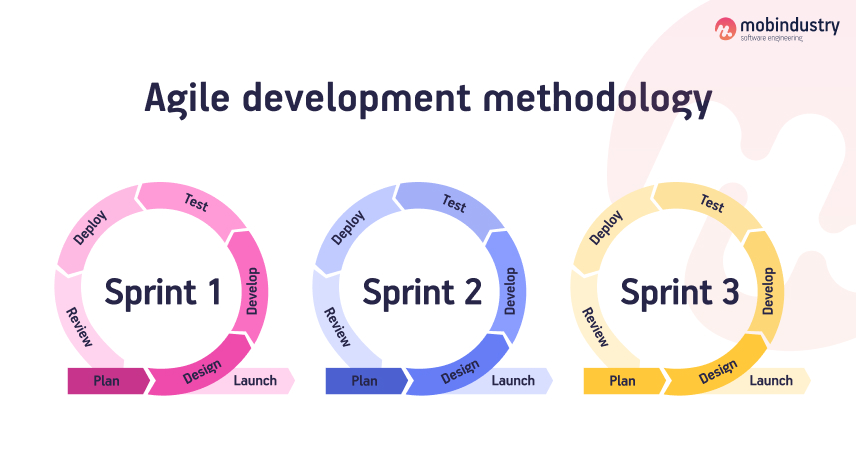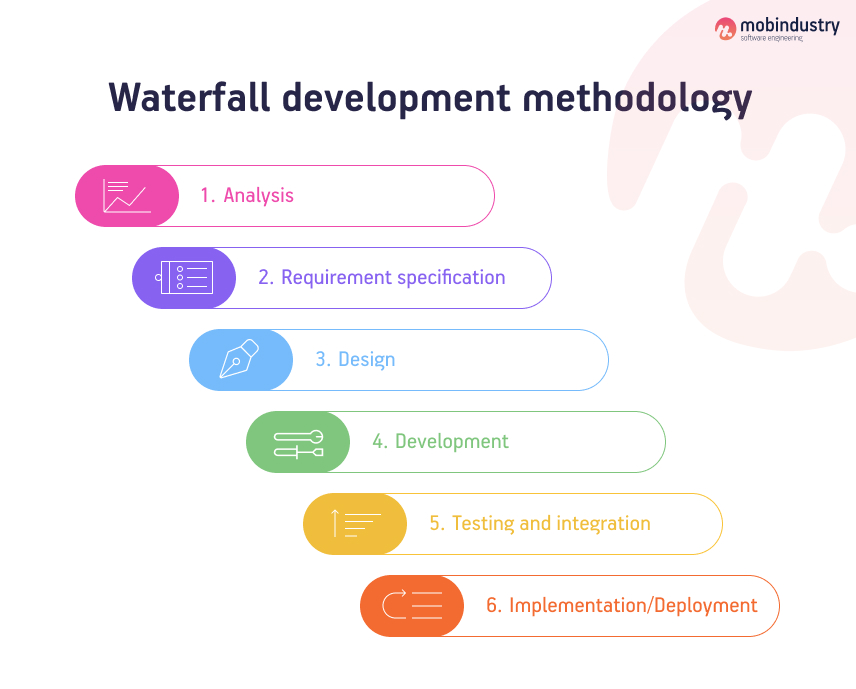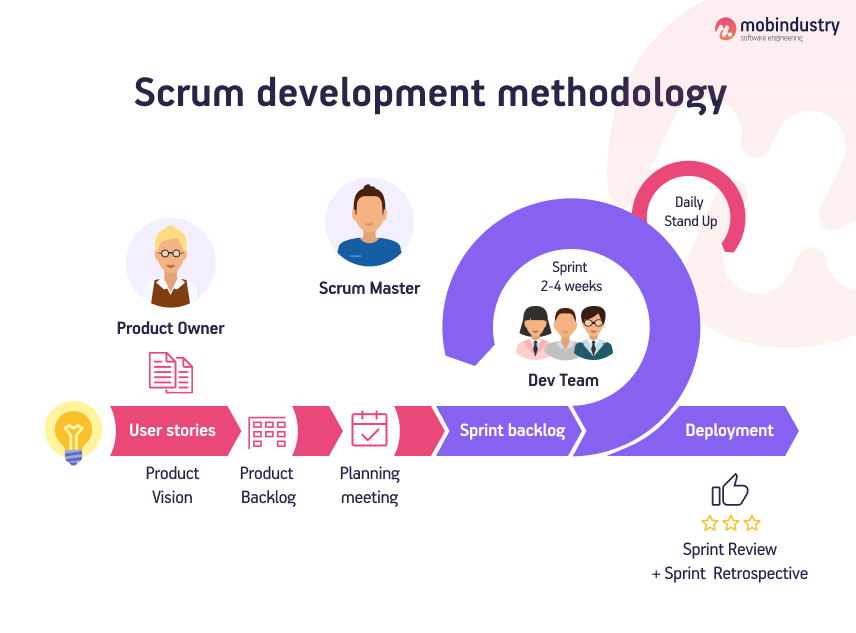Software Development Methodologies: How to Choose the Right One for Your Project
A software development methodology will determine your whole process of building a project. Learn what methodologies have proven successful for your particular project.
Software development isn’t the same as it was 20 years ago when you could build a world-class product like Facebook in your garage. Now the expectations from software are infinitely higher, and each project requires multiple specialists and parallel processes.
A methodology can make or break your project, because each method prioritizes different parts of the process and requires certain team configurations, skillsets, budgets and timelines.
As building software became more complex, people came up with various methodologies that would help facilitate collaboration on a project and optimize all the processes associated with software development.
In this article, you’ll learn about the software development methodology types that are used by modern companies that provide mobile and web development services.
Here you’ll also learn how to choose a software development methodology for your project.
What is a software development methodology?
A methodology for software development is a set of rules and practices that determine the whole process of building software. A methodology gives the team a concrete algorithm that helps to manage each individual process that happens during the development.
There are many different software development methodologies, each with its own pros and cons and addresses various challenges and goals. Your choice of a software development methodology will depend on factors like:
- Team size and structure
- Technologies
- Project size
- Business goals
- Software requirements
Let’s now compare software development methodologies based on their peculiarities as well as their advantages and disadvantages, and figure out how to choose a software development methodology after you hire web developers for your project.
Top 8 common types of methodologies in software development
Agile development methodology

Agile is currently the most popular methodology among developers. Its main idea is working on a product in iterations, meaning that the process happens in small pieces.
Iterations happen after sprints — set periods of time dedicated to developing prioritized features. A sprint can last 1-4 weeks depending on the product and the team configuration.
After each sprint, a team evaluates its success and decides on what’s developed next. This allows the team to be flexible in their work process and minimize the number of errors and bugs, as each piece of code is tested immediately after its implementation.
Pros and cons
- Flexibility and iterative process
- Quality and constant testing
- Increased speed
- Lack of focus
- Complex communication
- Lack of clear documentation
The pros of the Agile methodology include:
- Flexibility. Business owners can prioritize different features after each iteration based on their current business needs, user feedback, or changes in the market.
- Quality. By testing small parts of code, it’s easier to find and address the issues.
- Speed. Many processes happen simultaneously, saving time for development while increasing the quality of code.
Here are some cons of Agile:
- Lack of focus. If the changes to the project are required too often, a team may lose focus on the big picture.
- Communication. Agile requires lots of communication, and it may be challenging to manage, especially in bigger teams.
- Documentation. In hasty development, specialists don’t often have time to write and update the documentation, and it may become an issue later.
What is Agile suitable for
Agile works best in dynamic environments where requirements often change. It’s great for startups or business software that needs to react to ever-changing market expectations and standards. Just note, that your Agile team needs expert developers who are able to work independently, in order to orient themselves in a slightly chaotic environment.
Waterfall development methodology
Waterfall is a traditional methodology, the full opposite of Agile. It’s based on gradual processes that stick to a set plan, determined at the start of the project. It was the first methodology to appear, and it’s still used in some projects today.

A waterfall structure doesn’t suggest any unexpected changes, that’s why it’s easy to follow for less experienced teams. This, however, makes it too rigid for projects with changing requirements.
Pros and cons
- Clear and simple structure
- Comprehensive, detailed documentation
- Structured communication
- Lack of real-world feedback
- Lower code quality
- Lack of flexibility
The pros of a waterfall methodology include:
- Structure. The process of development is very clear and simple, so it’s easy to grasp for inexperienced developers
- Documentation. Every feature and aspect of the future software project is determined from the get-go
- Communication. Because everything is predetermined and documented, there’s no need for excessive communication
The cons of waterfall are:
- Lack of feedback and real-world testing. The idea of the project isn’t tested in real conditions, and it’s easy to miss the market after investing lots of time and money
- Code quality. Testing is done at the end of a project, so there’s more to fix, and some issues are hard to deal with because they are interconnected with other parts of the system
- Lack of flexibility. There’s really no room for changes, so it’s not suitable for most modern projects
What is Waterfall suitable for
Waterfall is suitable for small to mid-sized projects with a determined scope, that doesn’t require any flexibility, and the product isn’t too dependent on the market changes. Waterfall also works well for inexperienced teams.
Lean development
The main idea of lean development is to cut everything that’s unnecessary or redundant, from functionality and repetitive tasks to communication. The main task for developers in lean approach is to find bottlenecks that will hinder the process.
Developers need to take all factors into account and finalize the decisions through collaboration and communication with other team members.
Pros and cons
- Reduced cost of development
- Increased speed
- No waste of time on unnecessary functionality
- Highly skilled team is required
- Need for a very detailed documentation
The pros of the lean approach include:
- Reduced cost. Because developers only work on what really matters and cut everything else, the cost of development is lower.
- Speed. The work speed also accelerates due to focus on what’s important.
- No waste. The project is easy to deal with later because there’s no redundant code, unnecessary documentation, and so on.
The cons of the lean approach are:
- Skilled specialists are required. The decision-driven process in the lean method requires expert developers, so it’s harder to create such a team.
- Documentation. The lean approach requires lots of documentation, so you’ll need to hire a skilled business analyst.
What Lean development is suitable for
Lean approach works best for tight budgets and small projects. And, of course, a very professional, experienced team. With lean method, you’ll be able to get the most out of a small team of developers and launch your product fast.
Prototype model
When you don’t want to invest thousands of dollars in a product that has too many unknown variables, you choose to prototype: create a piece of software that can be tested and evaluated by customers. This is similar to creating an MVP, but it has even fewer features.
Prototyping allows you to gather feedback from your customers, and then invest into a fully-fledged product, knowing what will work best.
Pros and cons
- Reduced risks
- Lots of feedback from real users
- Reduced costs
- Need for extensive testing
- Risk of misunderstanding with users
- Risk of going over budget
The pros of prototyping include:
- Reduced risks. You can test your idea before investing money in it.
- More information. You can collect feedback and data from your customers to use it later in your product development
- Reduced costs. You can see what’s not really necessary at the early stages and choose to not invest in it
The cons of prototyping are:
- Too much testing. You risk losing focus and testing your prototype too much instead of going into development and releasing your product faster.
- Wrong perception. Your users may think that a prototype is your final product, and not realize it needs further polishing.
- Going over budget. Sometimes you may want to add too many features under the influence of user feedback, and significantly exceed the scope that was planned originally
What prototyping is suitable for
Prototyping works best for complex projects that have complex UX. These projects need their user interactions to be as simple as possible, while also giving the user access to all the functionality. Prototyping allows for gathering valuable user feedback in the early stages of development.
Rapid application development
It’s a type of Agile method that also uses an iterative approach. Its main goal is finding a balance between quality and speed of development.
RAD has four main steps: planning, prototyping, testing, and implementation. Unlike the Agile framework, RAD focuses more on prototyping and testing each feature with customers. This allows developers to ensure they’re making exactly what future users expect. The testing happens in iterations and stops the moment the user is satisfied with the product.
Pros and cons
- High level of user satisfaction
- Quick delivery and release to the market
- High success rate on the market
- Dependence on customer feedback
- Highly-skilled team required
- Lack of clear documentation
The pros of RAD include:
- Satisfied users. As the product is very dependent on feedback, users are more likely to get a product they’ll enjoy.
- Time-to-market. Through prototyping and iterative approach, the product can be released to the market earlier
- Higher success rate. Developers can use feedback to make sure the product doesn’t miss the market
The cons of RAD are:
- Dependence on customer feedback. It can be tricky to constantly seek out responsive customers who’re ready to provide you with feedback
- Highly-skilled team is required. RAD is quite complex and has changing requirements, so you need highly skilled developers and other specialists.
- Lack of documentation. Just like with Agile, it can be hard to keep up with the changing requirements and write detailed documentation
What RAD is suitable for
Rapid application development is suitable for small teams of experienced developers and users who are very involved in the process of building software. Your managers will need to handle lots of documentation and fast pacing of development. Also, you’ll need to invest in no- or low-code programming tools that are typically used in RAD.
The Dynamic systems model
This approach is very similar to Rapid application development. It also has four stages that include:
- Feasibility and business study
- Functional model
- Design and build
- Implementation
A lot of time in the Dynamic systems model is dedicated to prototyping, testing, and getting feedback from users. By dividing the whole development life cycle into iterative stages, developers get to deliver the core functionality fast.
The main goal of the Dynamic systems model is to keep the focus on business goals.
Pros and cons
- Fast delivery
- Focus on business goals
- Clear, detailed documentation
- Hard to implement
- Works only with a larger team
- High cost of development
The pros of the Dynamic systems model include:
- Fast delivery. Thanks to the iterative approach, this model allows developers to deliver features fast
- Focus on business goals. User feedback ensures that the functionality is developed with business requirements in mind
- Documentation. Unlike other Agile methodologies, Dynamic systems focus on keeping clear and detailed documentation
The cons of the Dynamic systems model are:
- Hard implementation. This methodology is rather tricky to implement due to its complex processes
- Team size. A small team will find it difficult to keep up with all the processes that include analyzing business requirements, getting feedback, and writing documentation
- High cost. The involvement of both developers and users can be quite costly
What Dynamic systems model is suitable for
This methodology is suitable for large organizations with enough budgets for bigger teams. This approach allows developers to divide a large and complex project into iterative sprints that are tested gradually and polished by getting user feedback.
Feature-driven development
Feature-driven development or FDD is another type of Agile method that is based on iterations. In this approach, however, iterations are connected with separate features. This doesn’t mean that FDD focuses on each individual feature.
According to FDD, the whole scope of activities is divided into separate features. Each of them is then planned, designed, and built. The implementation of each feature shouldn’t take more than 2 weeks to complete.
Documentation is essential for this approach, as each feature has to be described in detail for better understanding and team communication.
Pros and cons
- Fast delivery and release
- Efficiency and multitasking
- Clear processes and documentation
- Risk of losing focus on business goals
- Dependence
- Lack of clear documentation
The pros of Feature-driven development include:
- Fast delivery. The whole process is divided into smaller activities, which accelerate the work process
- Multitasking. A team can work on multiple tasks simultaneously without hampering the work process
- Collaboration. FDD is based on planning and documentation, so the process is clear to the whole team
The cons of Feature-driven development are:
- Risk or losing focus on business. This approach is very focused on activities, so a team can lose focus on user experience and achieving business goals
- Depending on a team lead. A highly skilled developer needs to take ownership of the whole process in order to coordinate other team members and simultaneous activities
What FDD is suitable for
FDD works best for large projects in big companies that have an opportunity to hire a larger team. It’s iterative, but more structured due to the focus on documentation.
Scrum development
Scrum was developed as an extension of the Agile methodology, taking everything great about it and adding more structure to the team. As one of the most advanced software development methodologies, Scrum has three main roles:
- Product owner
- Scrum master
- The development team

The product owner makes sure the business requirements are being met by communicating with the team and making sure each feature corresponds to the business needs.
A scrum master takes ownership of the actual development process and makes sure it corresponds to the Scrum best practices. The team executes the tasks.
Just like in Agile, Scrum divides the work into sprints that take no more than 4 weeks. During this time, a team has to identify issues, solve them, plan the activities, deliver the solution, test it and gather feedback. Because of such a narrow timeframe, the delivery process accelerates immensely.
Pros and cons
- Fast delivery
- Efficiency
- Communication
- Feedback
- Overcommunication
- Skilled team is required
- Not suitable for large projects
The pros of Scrum include:
- Fast delivery. Short sprints accelerate development
- Efficiency. Small tasks within a limited timeframe make the team focus on what’s important
- Communication. Scrum requires regular meetings that improve the communication between team members
- Feedback. Each team member receives feedback on their work, which motivates them and improves their skills
The cons of Scrum are:
- Overcommunication. For some team members, communication can be excessive
- Skilled team is required. All team members have to be equally skilled and familiar with Scrum
- Not suitable for large projects. Scrum requires too much communication and is hard to manage in large projects
What Scrum is suitable for
Scrum is perfect for small and mid-sized projects that have vague requirements that change often. Scrum is extremely flexible and efficient, so if you need to get an MVP fast and release it to the market as soon as possible, Scrum is great for that.
Final thoughts
A software development methodology can make or break your project’s success, that’s why it’s important to weigh all pros and cons and choose the perfect methodology for your project.
We at Mobindustry use Agile and its types in order to deliver the code fast without sacrificing the quality. We also focus on user and stakeholder feedback in order to keep our focus on business goals and requirements. This makes our projects more successful after their release.
If you’d like to learn more about project management or learn which software development methodology to choose, don’t hesitate to contact us. We’ll help you choose the right team and processes for your project.


